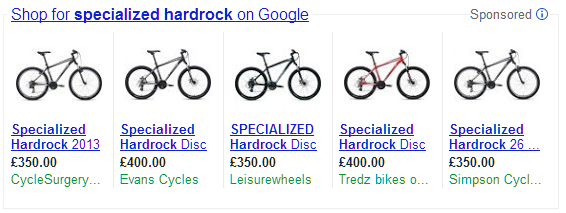
Product Listing Ads (PLAs) were introduced by Google last year as a way to deliver product specific ads containing an image. Google Shopping’s vertical product-specific results were later shifted to include only PLAs – all the old free results were removed. That change then followed across the globe, with the UK switching earlier this year.
You load all your product inventory into a feed (a structured spreadsheet, with an entry per product and descriptive fields determined by Google – e.g., Price, URL, Description, Size, etc). Make sure that feed is always up to date and upload it into Google Merchant Center, which provides some tools to manage it.
Link your Merchant Center account to AdWords, and you’re ready to start showing the nice product specific ads with images and prices included.
PLAs can be deceptively easy to set up, but there are still simple steps to take to maximise your returns.
How to Get it Working
You need to create a campaign that contains ad groups but no ads or keywords. Your campaign needs to have product extensions enabled to tell it which Merchant Center account to use data from.
In your ad groups you need to add:
- One or more targets. These are filters to determine which group of products should be eligible in this ad group. Consider this like your set of keywords.
- A promotion line. This is a bit of guidance about your ad. Google won’t always use it, but it’s there in case.
What Happens Next?
When a user does a search that Google deems product-related your feed will be scanned for products that match the search query used. Any matching products will then enter the auction.
There is a quality score-esque trade-off of relevance involved. Simply using a higher bid for a particular product in your feed won’t guarantee it to show for a search query if a different product is deemed more relevant to that search.
Google will also take historical and predicted performance into account, so you may find your products rotated between high price point, low price point, etc until Google settles on a product that performs well.
This is Pretty Different From Normal Search Ads
Yes. No keywords means a lack of control. You can still add negatives, but you cannot guarantee which products will show for which searches.
There are also no ad positions. In most formats (these are still being tested and won’t always be the same) five products will show beneath the banner, all in a row.
So you’re aiming for increased impression share if you want to improve volume, not ad position.
How to Optimize This in AdWords
A reduction in control doesn’t mean you should have no control. Each ad group can contain targets that act as filters on your products.
You can choose your entire inventory as a target, or you can set a target to be one brand, or one category, or even one product. You can specify custom labels in your feed then set up targets for each label.
The advantage of having products split into multiple targets is:
- More granular control over which products to show in PLAs. If you have some very low value products that might not work well on search, simply don’t include them in any targets.
- Individual promotion lines. This is like your ad text and can be different for each ad group. Put each target into an ad group of its own and then each target can have customized promotional lines.
- Different bids between targets. Some categories might have higher margins or sales values. More profitable products could/should have higher bids. By grouping those together you can make sure that the right products have the right bids.
This Sounds Like It’s Leading Somewhere
It is. The inevitable conclusion is that PLAs conform to normal best practices for search. The same way that each keyword should have a unique bid based on it’s profitability, so should each product.
Create a target per product so that each can have a unique bid. If your bid management system can cope then you can apply your normal search optimization techniques to each target.
It’s also a natural conclusion that you’ll want the ability to have unique promotional lines for each product if necessary. Using AdWords Editor or the API you can even include these in your feed and synchronize them automatically. But to do so means you’ll need an ad group per product. Since you’ll be managing the targets individually anyway, there is no significant overhead to having each target in its own ad group.
How Does This Help, and is it Worth it?
It’s definitely worth it if your PLA spend is non-trivial. If you currently split your targets by brand or by category then you’re using the same bid for the high margin and high value products as for low margin or low value products.
At the moment if one product accounts for most of your sales but a different one accounts for most of your spend, that’s tough. You wouldn’t consider running a search campaign based on keywords that way, so don’t do it for products either.
More granularity over bids and promotions means more control. More control allows you to reduce spend in unprofitable areas and funnel it into the areas that bring the best return.
There is more overhead this way, but consider that you’ve been having a bit of a free pass with PLAs up to this point. If they’ve taken a fraction of your overall account management time to look after, but delivery non-trivial spend and revenue, then they deserve the extra time.
